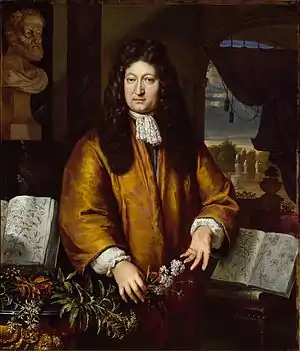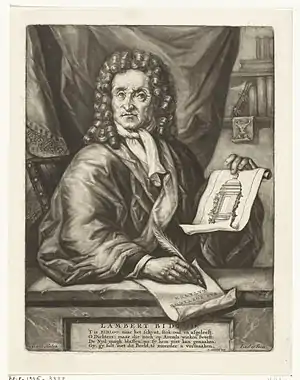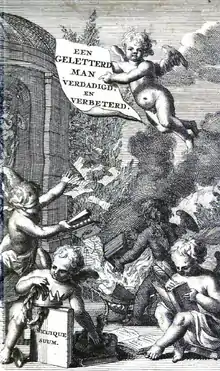Lambert Bidloo | |
|---|---|
 Lambert Bidloo, by Jacobus Houbraken | |
| Born | 30 August 1638 Amsterdam |
| Died | 11 June 1724 Amsterdam |
| Occupation | Pharmacist, writer |
Lambert Bidloo (30 August 1638 – 11 June 1724), of Amsterdam, was by religion, a Zonist Mennonite, by profession, an apothecary and botanist and by passion, a man of letters and translator. After a solid education in classical letters and a period of apprenticeship, Lambert joined the apothecaries' and surgeon's guild overseeing standards and education at the Collegium Medicum. In 1688, he became the director of this institution, and, along with associates and collaborators, botanist Jan Commelin and anatomist Frederik Ruysch he had a hand in its herbalist Hortus Medicus flowering into the global Hortus Botanicus (Amsterdam) of today. His various learned works in Latin and Dutch deal with plants, with Mennonite religious issues and with different historical themes, contemporary, biblical and literary. Among these Bidloo is best known for the curious Panpoeticon Batavum, (Amsterdan, 1720), a figurative and visual poet's gallery of Golden Age Dutch literature. This he produced as a joint undertaking with the noted artist and art historian Arnold Houbraken who was then also launching The Great Theatre of Dutch Painters, (Amsterdam, 1718–21).
Early life
Lambert was the first son of Mennonites Maria Lambertz Fellers and Govert Bidloo, (b. 1603), a hatter by trade.[1] Govert was thirty five when his first son was born in 1638. Eleven years later a second son, Govert, named after himself, was born in 1649. Both brothers pursued scientific careers: Lambert in botany as an apothecary, and Govert in anatomy and as a professor of surgery. As writers, both wrote many poems, religious treatises, scientific and historical works and translations, and theatrical and musical pieces, including the first Dutch opera.[2]
In contemporary Amsterdam, Bidloo's intellectual and literary pretensions were perceived as conceited.[3] He was not the only poet-pharmacist of his time: Joannes Antonides van der Goes, a noted disciple of the great poet Vondel was not only a fellow pharmacist but a Mennonite as well, along with Jan Brouwer.
"Amstela dulcis"
_1699-1706_by_Frederik_de_Wit.jpg.webp)
In 1665, Bidloo's first publication—Menno's Church—was printed as part of the "Lammerenkrijg" among the Amsterdam Mennonites. From his marriage with Maria van der Lys in 1666 he had four children: John, a merchant who settled in Lisbon; Maria, who became her father's amanuensis; Nicolaas Bidloo, who went to Russia and served as a personal physician to Peter the Great; and Celia, who married Cornelis De Bree, compass maker.[4] In 1672 (also known as the Rampjaar), Bidloo composed a mythological paean to the Batavian river gods who had rescued Holland from the French and English river deities set on Dutch destruction. His Latin poem "Amstela dulcis" appeared in 1674.[5] It recounts the upheavals of war on land and sea, including the flooding of the Dutch Water Line and the rescue of Amsterdam from the country's occupation by Louis XIV. The work is dedicated to two men at the top of Amsterdam's political leadership: burgomaster Gillis Valckenier and counselor Johannes Hudde. It appeared after the De Witt brothers' deaths.
"De re herbaria"

Lambert trained as an apothecary at the Athenaeum Illustre of Amsterdam where Latin was the language of instruction and a professional requirement. Aside from studying botany, chemistry, and pharmacology, he also became proficient with languages.
Commelin's first publication was in Dutch Nederlands Hesperides 1676. This treatise on lemon and orange trees in Holland was published in English in 1683.[6] In the same year, Commelin's first work in Latin was published in collaboration with Bidloo.[7] Commelin's Catalogus plantarum indigenarum Hollandiae opens with Bidloo's essay "De re herbaria".[8]
In 1688, Bidloo was elected as the supervisor of the medical college.[9] At the time, Bidloo's intellectual and literary pretensions were perceived as conceited.[10]
"Zonist" Mennonite

%252C_RP-P-OB-48.475.jpg.webp)
Bidloo was a leading member of the Amsterdam Mennonites called "Zonists" for the name of their meeting place on the Singelgracht, "op te Zon". The Mennonites (also known as Doopgezinden) were an independent Anabaptist group originating in the Netherlands at the onset of the Protestant Reformation. During the Munster Rebellion (1534–35), a splinter group staged a temporary social revolution which endangered their existence and were ostracised for their role in the Radical Reformation. The group was severely persecuted for their dissident beliefs, such as believer's baptism, foot washing, "defenseless" pacifism, and the ban on swearing oaths. These Mennonite principles are enumerated in the 18 points of the Dordrecht Confession of Faith (1632).[11] By Bidloo's time his church was emerging from its clandestine status into congregational meetings that were tolerated by the Calvinist officialdom out of the public eye. By 1660 the differences between liberals and conservatives provoked a major schism among the Mennonites that would persist, despite repeated attempts at reunification, until 1801. The liberal "Lamist" Mennonites were led by Galenus Abramsz de Hann while the conservative "Zonists" were led by Samuel Apostool. The Zonists disapproved of the Lamists' practices; therefore, they set up their own congregation and organized against what they saw as the betrayal of their traditions and the heresy of their former co-religionists.[12]
Bidloo was a fervid Zonist from the beginning of the schism and wrote contentious pamphlets against the Lamists' more inclusive and tolerant views of the "Flemish" congregation: "Op te Lamm".[13] Bidloo's contemporary and fellow Zonist, Thieleman J. van Braght, produced a martyrology—Martyrs Mirror—for his co-religionists.[14] The book became a fundamental text for all Anabaptists, especially through Jan Luiken's illustrated second edition of 1685.[15] In a similar vein, but with a smaller scope was one of the first publications of Lambert's brother Govert, Letters of the Marytyred Apostles (1675).[16] During Govert's lifetime there were 20 editions of his work which include a poem contributed "by his brother".[17] While Mennonite beliefs were an important components in the art (Rembrandt) and poetry (Vondel) of the Dutch Golden Age, Bidloo's conservative religious beliefs distanced him from the Dutch origins of the "Radical Enlightenment".[18]
Panpoeticon Batavum

Bidloo contributed poems to artist Arnoud van Halen as part of the Panpoeticon Batavum (1720).[19] This, Bidloo's best known work, is the poetic component of a fascinating gallery of miniature portraits,[20] partially preserved in the Rijksmuseum. Bidloo's poetic review of the best Dutch writers constitutes one of the first historical presentations of this literary tradition.
Een Geletterd Man verdadigd en verbetterd

Among several projects the elderly Bidloo fulfilled his commitment to translate L'huomo di lettere (1645) of the Ferrarese Jesuit writer, Daniello Bartoli (1608-1685). For those aspiring to the title of man of letters this treatise was celebrated as the template of Italian eloquence during Bartoli's lifetime. By 1722 the book had been translated into German, French, Latin, English, and Spanish. Bidloo's Dutch rendering of the Italian work is entitled Een Geletterd Man verdadigd en verbettererd, proposing the defense and bettering of Bartoli's "lettered" man, as a Stoic model of Christian humanism. His preface begins with a dedication to his faithful daughter Maria, his "bibliothecaria". In his foreword Bidloo describes his introduction to Bartoli's Baroque bestseller years earlier at the Congress of Nijmegen (1677–78) by the papal nuncio of Innocent XI. This dignitary, Aloysius Bevilacqua, touted it to him as a challenging literary summa. Before the text there are several occasional poems attached by other poets, including fellow Mennonite Pieter Langendijk. Bidloo innovates by adding numbers to the series of headings; in Part I, 1-11 ; Part II, 1-27 .[21] After Lambert's death in 1724, Hendrik Bosch, his Amsterdam printer, together with his two daughters as publishers, issued a final work in three volumes on the resonant theme of the downfall of the Jewish people.[22]
References
- ↑ "Maria Lambertsz Feliers". www.vondel.humanities.uva.nl. Retrieved 2020-06-29.
- ↑ Bacchus, Ceres en Venus 1686, music by Johan Schenck and libretto by Govert Bidloo
- ↑ Luuc Kooijmans. Death Defied: The Anatomy Lessons of Frederik Ruysch,(2004) trans. Diane Webb. Leiden: Brill, 2011.
- ↑ Ecartico
- ↑ 1674
- ↑ The Belgick or Netherlandish Hesperides. That is the Management, Ordering, and Use of the Limon and Orange Trees, Fitted to the Nature and Climate of the Netherlands. London: J. Holford, 1683.
- ↑ it is frequently referred as Nederlandse Flora in Dutch, though only the Latin text exists.
- ↑ Amsterdam
- ↑ Casper Commelin, Beschryvinge van Amsterdam: zynde een Naukeurige verhandelinge van desselfs eerste Oorspronkt uyt den Huyse der Heeren van Amstel en Amstellant, haar Vergrootingen, Rykdom, en Wyze van regeeringe, tot den jare 1691, (1726) IV, 501.
- ↑ Luuc Kooijmans. Death Defied: The Anatomy Lessons of Frederik Ruysch,(2004) trans. Diane Webb. Leiden: Brill, 2011.
- ↑ https://gameo.org/index.php?title=Dordrecht_Confession_of_Faith_(Mennonite,_1632)false=
- ↑ Francesco Quatrini, Adam Boreel (1602 – 1665): His Life and Thoughtore.ac.uk/download/pdf/80203718.pdf
- ↑ Mennoos kerck, in en uyt Babel, ofte den aenvang, voortgang en redderinge van der verwarringen der Vlaemsche Doops-Gesinden, vergeleken met de tseventighjarige gevangenisse en bestellinge der Israëliten, Lambert Bidloo, T'Amsterdam : Voor Samuel Imbrechts, 1665
- ↑ The full English title of the book is The Bloody Theater or Martyrs Mirror of the Defenseless Christians who baptized only upon confession of faith, and who suffered and died for the testimony of Jesus, their Saviour, from the time of Christ to the year A.D. 1660
- ↑ Het bloedig tooneel, of Martelaers spiegel der doops-gesinde of weereloose christenen, die, om 't getuygenis van Jesus haren salighmaker, geleden hebben, ende gedood zijn, van Christi tijd af, tot desen tijd toe Amsterdam 1685
- ↑ Govert Bidloo, Brieven der gemartelde apostelen (Amsterdam: Hieroymus Sweerts, 1675). Plates by Romeyn de Hooghe.
- ↑ "Govert Bidloo, Brieven der gemartelde apostelen · DBNL".
- ↑ Cf. Jonathan Israel, Radical Enlightenment: Philosophy and the Making of Modernity, 1650–1750 2001.
- ↑ Op het Panpoëticon Batavum, Kabinet der voornaamste Nederlandsche Digteren, in Vaerzen beschreven Door den Heere Lambert Bidloo (in Dutch).
{{cite book}}:|work=ignored (help) - ↑ Visualising literary heritage: A viable approach? The case of the Panpoëticon Batavûm, Lieke van Deinsena, Timothy De Paepeb, 2017.
- ↑ Een Geletterd Man Verdadigd, en Verbeterd door Daniel Bartholi1722
- ↑ Verwoesting des joodschen volks : aanvangende met den afval der X stammen onder Jereboam, en eindigende met bynaar dezen tegenwoordigen tyd Lambert Bidloo; Jan Caspar Philips; Jacobus Houbraken, Amsterdam, Hendrik Bosch, 1725-1727.